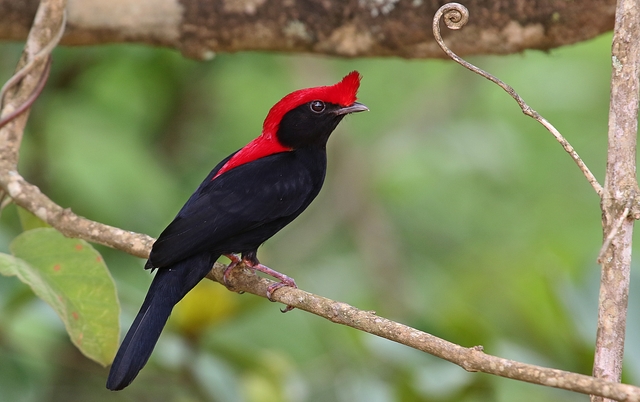Classificação Científica
| Reino: | Animalia |
| Filo: | Chordata |
| Classe: | Aves |
| Ordem: | Passeriformes |
| Subordem: | Tyranni |
| Infraordem: | Tyrannides |
| Wetmore & Miller, 1926 | |
| Parvordem: | Tyrannida |
| Família: | Pipridae |
| Rafinesque, 1815 | |
| Subfamília: | Ilicurinae |
| Prum, 1992 | |
| Espécie: | A. galeata |
Nome Científico
Antilophia galeata(Lichtenstein, 1823)
Nome em Inglês
Helmeted ManakinHelmeted Manakin
The Helmeted Manakin belongs to one of the most colourful groups to be found in the Brazilian forests, the Pipridae. Several species are found in both the Amazon Basin and the Atlantic Rain Forest. The Helmeted Manakin occurs in the gallery forests of central Brazil and in the woodlands of the Pantanal. It is also found in Mauritia palm groves or in swampy woodland at between 500 and 1000m altitude. Occasionally it accompanies mixed flocks. It is found in Maranhão, Piauí and from Bahia to Mato Grosso, Goiás, Distrito Federal, western Minas Gerais, western São Paulo (from Pirassununga northwards), Paraná, Paraguai and Bolívia.
Etymology: Antilophia - from the Greek antios = different + lophios = crest; galeata - from the Latin galeatus = protected with a helmet (galea = helmet).
The Araripe Manakin is a species with colouring adapted to the clear, sunny climate of the dry north-east of Brazil, or caatinga, which was discovered recently in Ceará.
Characteristics
It measures about 14.5cm. Like the majority of species in this family, the male is different from the female. It has a very large bright red crest which stretches from the top of the head to the middle of the back, with black plumage over the rest of its body. Above the bill, a tuft of longer feathers points forward in a striking manner forming the feature that gives the bird its English, Brazilian and scientific names. The female and the fledgling male are uniform green in colour. The young male takes three years to reach full adult plumage. During this period males with gradually increasing amounts of red and black showing through the green can be observed.
Food
It feeds mainly on fruits with the male generally foraging at a higher level than the female. They also feed on insects caught from a height of 1 metre above the ground to the top of the canopy.
Breeding
The male mates with at least one female and they remain within the breeding territory for the whole of the breeding cycle. Apparently the female builds the nest alone. The male has no involvement in the incubation or the care of the young. Adult males all territorial for the whole year with exclusive territories defended with song and chasing off other adult males with pursuit flights below the canopy. The nest is in the form of a shallow cup attached to a fork in a tree. One or two greyish eggs are laid. The incubation period is 17 to 19 days and is carried out exclusively by the female. The nestlings receive from the mother small fruits and insects partly regurgitated and partly mashed up in a ball. They fledge at between 13 and 15 days old. In some regions in the south-east they hybridise with Chiroxiphia caudata.
Habits
They are mainly solitary and sing throughout the year including during moult which takes place between January and May. It is a series of fast, rich musical notes in five parts with the first note separate, shorter and slower. The others follow in rapid succession. During the breeding season it responds to playback or imitations.
Distribution
References
Antas, Paulo de Tarso Zuquim e Palo Jr., Haroldo. Pantanal - Guia de Aves, Sesc.
Frisch, Johan Dalgas e Frisch, Christian Dalgas. Aves Brasileiras e Plantas que as Atraem, 3a. edição.
Marini, Miguel Ângelo. 1989. Comportamento social de Antilophia galeata em mata de galeria do DF. Tese de Mestrado, Ecologia, Universidade de Brasília.
Sick, Helmut. Ornitologia Brasileira, Uma Introdução, 2a. Edição, Editora Universidade de Brasília.
Sigrist, Tomas. Aves do Brasil, Uma Visão Artística, 2a. edição, Avisbrasilis.






















